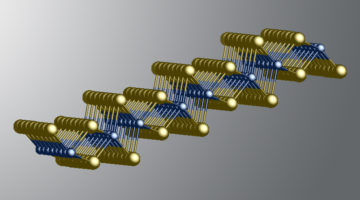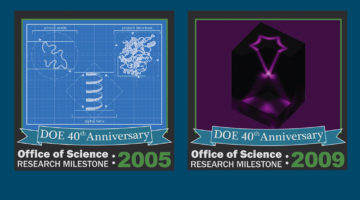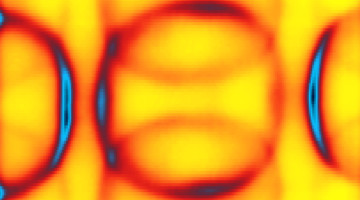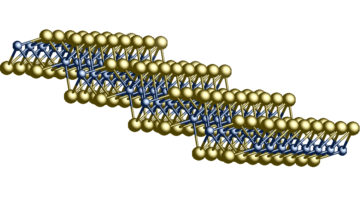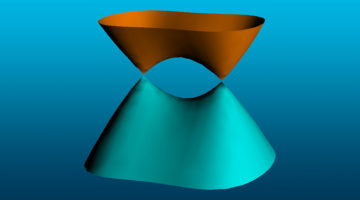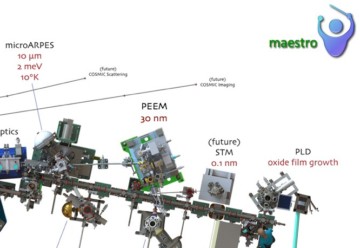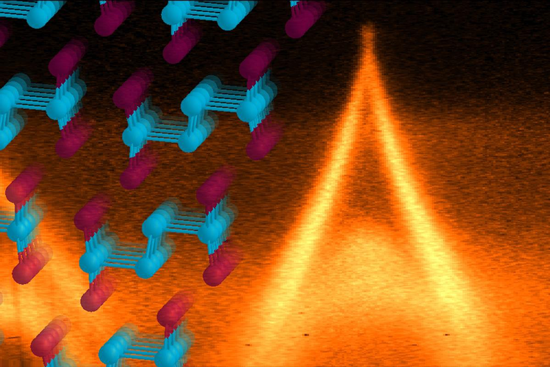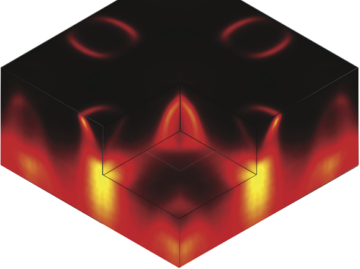Researchers have established that a particularly stable form of WTe2 is a two-dimensional topological insulator, confirming recent predictions. The findings should provide new opportunities for fundamental studies of topological phenomena and for next-generation spintronic applications. Read more »![]()
![]()
ALS Work Using ARPES
Angle-resolved photoemission spectroscopy (ARPES) is a technique in which a highly focused beam of x-rays is used to kick electrons out of the sample. By analyzing the ejected electrons' direction and energy, the researchers can obtain the material's band structure—a map of the electrons' behavior in the material.
ALS Work Highlighted in DOE Top 40 Countdown
To celebrate DOE’s 40th anniversary (October 1, 2017), the Office of Science (SC) collected 40 scientific milestones from the previous 40 years, each one supported by SC. The ALS played a key role in two of the milestones: 2005 (ribosome) and 2009 (topological materials). Read more »
The Mystery of the Lightweight Electrons
Copper oxides are important for superconductivity applications but are difficult to understand due to complex charge, spin, and orbital interactions. Now, studies at the ALS have found such a system in which observations of effective electron mass are at odds with state-of-the-art electronic-structure calculations. Read more »
2D Material’s Traits Could Send Electronics R&D Spinning in New Directions
Working at the ALS, researchers have found another family of materials where they can both explore the physics of 2D topological insulators and do experiments that may lead to future applications. The material—known as 1T’-WTe2—bridges two flourishing fields of research: that of so-called 2D materials and topological materials. Read more »
Strain Turns Tin into a 3D Topological Dirac Semimetal
A small amount of compressive strain turns a nonmetallic form of tin into a 3D topological Dirac semimetal—a kind of “supermetal” with very high electron mobility. With its rich topological phase diagram, the material shows promise for both novel physics and eventual device applications. Read more »![]()
![]()
ARPES Overturns V2O3 Metal-to-Insulator Theory
Researchers report on angle-resolved photoemission spectroscopy (ARPES) measurements performed on the transition-metal oxide V2O3. The results overturn a decade-old theory about metal-to-insulator transitions in this material and provide a spectroscopic benchmark test for future models. Read more »![]()
![]()
Altered States in Graphene Heterostructures
ARPES directly reveals for the first time how electronic states are altered when epitaxial graphene is deposited on a substrate of hexagonal boron nitride (h-BN). The interaction between the materials in this heterostructure greatly improves its suitability for advanced, ultralow-power device applications. Read more »![]()
![]()
MAESTRO Beamline Set to Open to Users
This September, Beamline 7.0.2, MAESTRO, will accept general user proposals for the first time. Its unique attributes combine strong sample preparation capabilities with cutting-edge spectromicroscopy tools, offering researchers unparalleled opportunities for studying the correlation between structure and electronic properties. Read more »
A Novel Quasi-1D Topological Insulator
The tantalizing prospect of energy-saving, ultralow-power electronics has led to a vigorous search for optimal topological insulator materials. Now, an international team of scientists has discovered the first of a new class of topological insulators with unique properties: quasi-1D bismuth iodide. Read more »
A New Universal Parameter for Superconductivity
Scientists have been researching high-temperature (high-Tc) superconductors for decades with the goal of finding materials that express superconducting capabilities at room temperature, which would be a requirement for practical and cost-effective applications. The newest materials to gain scientific interest are iron-based superconductors, and the latest research from the ALS on these materials indicates a new factor that determines their superconductivity. Read more »![]()
![]()
- « Previous Page
- 1
- …
- 4
- 5
- 6
- 7
- 8
- Next Page »
